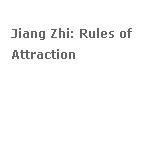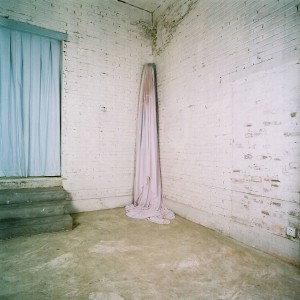Jiang Zhi: Rules of Attraction
 By Jonathan Thomson
By Jonathan Thomson
Attraction is all about making connections. Attracting people or things, drawing them closer to oneself or other things, and the ways in which those connections are made (or at the very least made possible) have concerned countless generations of physicists, philosophers, social psychologists, biologists, poets and lovers. Especially lovers. Elizabeth Barrett Browning’s sonnet that begins with the timeless lines “How do I love thee? Let me count the ways” strives to enumerate the myriad possible connections and to illuminate the mysteries of passion and desire.1
Browning knew, and her work articulates the fact that attraction works simultaneously on many different levels. Making connections is also at the heart of Ludwig Wittgenstein’s philosophy. Widely considered to be the most influential philosopher of the 20th century, Wittgenstein imparted a way of thinking and understanding not by saying what was distinctive about it, but by showing how it can be used to clarify one’s ideas. His ideas hinged on keeping in mind that things are as they are, and on seeking illuminating comparisons to get an understanding of how they are.2 Illuminating comparisons help us to sense hitherto unnoticed distinctions and relations between things and suggest a proper connectness and relatedness, both with each other, and with our larger surroundings. For Wittgenstein, an illuminating comparison or “perspicuous representation produces just that understanding which consists in ‘seeing connections’’’.3
But drawing connections is a risky business as it “can often appear as if one is making assertoric statements, claims to truth to the effect that there is such and such a connection, and then can arise the question ‘Well, is there, in reality such a connection or not?’ Think for example of seeing a likeness between two faces, say those of a mother and her baby. Some people can see it and others can’t, and if a dispute breaks out about whether this likeness is real or only imagined, how is it to be resolved? Is there a fact here that one can appeal to? Can one say, ‘Look, there is either a likeness here or there isn’t.’ One can point to one face and then to the other, but can one point to the connection between the two? One can draw one face and then the other, but can one draw the similarity between them? Seeing connections provides us at once with the most familiar form of understanding and the most elusive. What eludes us, in particular, are direct statements of what, exactly, is understood.”4
What then can we say about the work of Jiang Zhi in his exhibition On the White? Some of these works, images of human figures constrained within a gauze shroud, appear to be making a statement about the connections between people and their attraction for one another. In the series titled Fate, we sense the figures either locked together in an embrace, or straining to repel one another. Their bodies and gestures tension parts of the gauze, drawing it into vectors that help to articulate the connections between them, leaving other parts crumpled in flaccid piles on the floor. In On the White the figures are at a distance from one another but within the same proximity.
The gauze gives the figures form but cloaks them in mystery. Jiang Zhi distinguishes his work from (say) the wrapped objects of Christo and Jean Claude. He observes that their kind of wrapped works “will definitely be able to reveal the feeling of mystery, it will change the original form, and allow more people to be interested in the change of the form, wrapped up its own characteristics. However, in my work, [the intention] is more to wrap it up without a specific image; it is a movement, there is a force inside to make it become more abstract. There will be some folds and detailed things, and those things can enrich the feeling. I will not simply make an object to be a square or a circle for expressing feeling, but express it according to the movement of human body.5 Jiang Zhi himself does not wish to over-elaborate these works. He notes that while “for most of the people, the works seem to be very poetic, but I can not very accurately describe to you how the poetic feeling can be revealed.”

The colour of these new works is significant. In the past, many of Jiang Zhi’s works have been concerned with light. For him, the use of white in these works may be seen as an alternative to light. “I think the relationship between them may be, in fact, white cloth is also light’s variations. It is like a diffused light. White is a very well reflected light’s carrier. White is also a colour with particular cultural significance. “For traditional Chinese, white is a symbol of cleanliness, a kind of emptiness. It is also symbolic of the supremacy of a certain state of mind, and there are many different explanations of this concept. In Buddhism, there is a legend that people after death will enter a realm of Nirvana, only in white and no darkness. This is one of the realms for people after death to enter.” The colour also gave rise to the motif and structure in many of Jiang Zhi’s recent works. “In fact, white has given me a basis of the form of my works. This basis may be relatively withered and empty and pure. I do not wish to explore problems of reality or the current political problems. Those issues are more about a creation of outward concern, and my work is more introverted. I feel my work has more force, confrontation, entanglement coexistence and contradictions. I am more concerned about fate, and have reflected it in my work.”
In his works involving light, “the light beam is a very strong confrontation, it is just like two powerful things in opposition. In this series of “white cloth”, there is no confrontation between black and white, no strong difference between light and darkness. It is because fate itself is vague, it will not only be a matter of either black or white, neither black nor white, it is more about a similar value.” In a similar vein, the great abstract painter Wassily Kandinsky described white as “a symbol of a world from which all colour as a definite attribute has disappeared. This world is too far above us for its harmony to touch our souls. A great silence, like an impenetrable wall, shrouds its life from our understanding. White therefore, has this harmony of silence, which works on us negatively, like many pauses in music that break temporarily the melody. It is not a dead silence, but one pregnant with possibilities. White has the appeal of the nothingness that is before birth, of the world in the ice age.”6
Jiang Zhi’s works are also replete with possibility. The bodies that are caught within the gauze are in effect a moveable sculpture. Jiang Zhi is interested to express the ways in which they work within the limitations of the space but also how they are constantly testing its boundaries, and using the force of their movements and the restraint of the cloth as a form of balance. The work may be taken as a metaphor for society. “It is about relationships among people, more specifically, the relationship between men with women. A kind of coexistence, they also have connections to each other but also want to escape from such a relationship. They do not know if they are willing to do it or being forced to do so. They are really inside a devil, inside a nuclear bomb.” The artist directs his performers to use the movement of their bodies to “say something about the relationship between men and women, something about on the symbiosis, destiny, entangled and their experience. But the concrete movement they will do or what form will be shaped in the cloth, they are free to elaborate.”
In some works the figure describe a spatial and a psychological relationship while ensconced within the same shroud. In others they occupy different places within a room and the room itself becomes charged with meaning. “In the works of On The White, this space may give us a sense of distance, like the two rooms’ distance, they seem to be separated, but are connected. Just like two tracks, the feeling is that they will have their own parts. The two individuals have their own spaces and do not have a very close relationship. In the works of Fate they may refer to something like fate, that is flat and continues to infinity, there is no deflection in the space. In the works of Corner, there is a very obvious deviation. A kind of loneliness is in the corner and you have the feeling that you have no way to escape from it.”
Not all of the works in this exhibition are white or involve the physical movement of people. After the earthquake in Wenchuan, the artist created a group of photos with black cloth that can be described as a kind of black in black. “One time, I went into a space, then suddenly entered into a house in darkness, through the black cloth, occasionally I could see the things outside, but the people outside do not know that I am looking at them from inside. Suddenly there is a feeling of death, because am just thinking of a major earthquake in Wenchuan where there are many people buried in the ruins. In the darkness, they may be able to hear voices from outside, or see a little bit of a glimpse from outside, or they were completely insulated. So there are three levels, one is black and white in contrast, very strong, a bundle of light in the darkness. The second one is a kind of white, a kind of diffused light that is not based on the confrontation. It is on a rather unified basis for discussing some fundamental problems. Last level is in the darkness, black in black, that kind of weak light, a glimpse of light.”
Often times it may be artists who are best able to make the illuminating comparisons or perspicuous representations that Wittgenstein felt could assist us to see connections. The trick is being able to present information in such a way as to assist people to “condense fact from the vapour of nuance”7. The human mind can absorb and process a tremendous amount of information, if it comes in the right format or in such a way as to make those connections explicit. Finding the right format is crucial. In his recent works, Jiang Zhi may well show us the way.
1.Elizabeth Barrett Browning, “Sonnet 43”, Sonnets from the Portuguese, Kessinger Publishing, 2004, pg 26.
2. Ray Monk, Ludwig Wittgenstein: The Duty of Genius, Vintage, London, 1991, pg. 451
3. Ludwig Wittgenstein, Philosophical Investigations, Translated by G. E. M. Anscombe, Blackwell, Oxford, 1958, Section 122.
4. Ray Monk, “Philosophical Biography: The Very Idea” in Wittgenstein: Biography and Philosophy, ed. James C. Klagge, Cambridge University Press, Cambridge, 2001, pg. 5.
5. Telephone interview with Jiang Zhi on 13 August 2008. Transcript translated by Janet Fong. Unless otherwise stated, all direct quotes are from this interview.
6. Wassily Kandinsky, Concerning the Spiritual in Art, Translated by MTH Sadler, Dover Publications, New York, 1977, pg 39.
7. Neal Stephenson, Snow Crash, Penguin, London, 1992, Pg. 56.